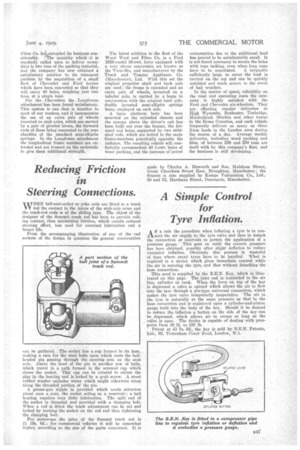A Simple Control for Tyre Inflation.
Page 73

If you've noticed an error in this article please click here to report it so we can fix it.
AS a rule the procedure when inflating a tyre is to connect the air supply to the tyre valve and then to detach
• the connection at intervals to permit the application of a pressure gauge. This goes on until the correct pressure has been obtained, possibly after slight deflation to reduce • excessive inflation. Obviously this process is wasteful of time where many tyres have to be handled. What is • required is a device which gives immediate control while the air is entering the tyre, and that without detaching the hose connection.
This geed is supplied by the I3.E.N. Key, which is illustrated on this page. The inlet end is connected to the air line, cylinder or tank. When the lever on top of the key is depressed a valve is opened which allows the air to flow Into the ti-re through a pin-type universal connection, which makes the tyre valve temporarily inoperative. The -air in the tyre is naturally at the same pressure as that in the hose connection and is registered upon a cylinder-and-piston gauge built into the body of the key. Should it be desired to reduce the inflation a button on the side of the key can be depressed, which allows air to escape so long as the valve is open. The device is capable of dealing with pressures from 20 lb. to 120 lb.
' Priced at £3 7s, 6d., the key is sold by 13.E.N. Patents, Ltd., 92, Tottenham Court Road, London, W.1.




















































































































